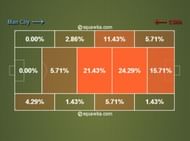Tactics, like civilizations, have certain eras which underline the beginning and end of their existence. Over the many decades that the beautiful game has evolved and changed, footballing philosophies have come alive and faded away, all just a part of the dynamic nature of football and its many characteristics. A similar era in the past decade or so has seen the rise to prominence of two significant terms, ideas which have played a major part in yet another revolutionary tactical innovation. The first is a term even plastic football fans are aware of – tiki-taka.
The second is a recent characteristic of sides which have capitalized on the beauty of fluid attacking transitions and the invaluable gift of creating space, a tactic now familiar as the False 9. One side in particular has become synonymous with both during the past few years, notorious for prolonged spells of possession sustained by beautifully crisp, short passing sequences, and the nerve to step out in an international tournament without a recognized centre forward. La Furia Roja’s rise is attributed to these two factors, one World Cup and two European Championships have proved their credentials beyond measure.
But as is the problem with any piece of tactical ingenuity, flaws are inherent and there to be exploited. AS Roma’s adventure with the False 9 ended in a 7-1 thrashing at the hands of a rampant Manchester United, Barcelona’s tiki-taka was foiled magnificently by Mourinho’s Inter, who went on to win the Champions League that campaign. The False 9 has been severely threatened by teams which hold a deep defensive line and counter swiftly, likewise tiki-taka has met its match in teams which press relentlessly while being organized at the back.
So is the era of the False 9 finally coming to an end? The signs after Euro 2012 do indicate that Spain’s intimidating domination may finally be on the decline. A 3-0 loss to Brazil in the Confederations Cup, coupled with shaky performances in friendlies including a significant low of conceding against Equatorial Guinea (ranked 119th in the world) and a recent loss to South Africa have dented the momentum which gave Vicente Del Bosque an astounding 81% win percentage at one point. Now, Spain are backed at 7/1 to lift the trophy next year (behind Brazil and Germany), both coincidentally, are sides which are lethal on the counter. But where one civilization falls, the other begins. Spain has never had a dearth of talent, and that offers them an effective solution to the waning effectiveness of the False 9.
Looking back at the past year and a half, the default 4-2-3-1 revered by so many sides has undergone a change, with managers now looking towards a formation which incorporates two forwards. Robin Van Persie and Wayne Rooney’s endeavors fired United to a title last season, and sides everywhere added inside forwards and centre forwards to their line ups. Dortmund signed Pierre Emerick Aubemayang, the lightning quick Gabon attacker who can play up front or as an inside forward. Barcelona signaled their intent with the purchase of Neymar, PSG signed Edinson Cavani and Madrid bought in Gareth Bale, who offers a more direct goal scoring threat as well as added versatility (the only logical conclusion to Mesut Ozil’s sale) to the side. In England, this trend was far more observable, with the emergence of SAS, the name assigned to the prolific pairing of Suarez and Sturridge, and the almost telepathic understanding between Sergio Aguero and Manchester City’s newest recruit (and one half of Spain’s potential solution) Alvaro Negredo.
Much of Manchester City’s strong start to the Premier League season has been down to their talismanic strike duo of Negredo and Aguero. Out of Manchester City’s 53 premier league goals tally, the pair has chipped in 21 times. Negredo himself has settled in well in his first season in England, forging a fantastic partnership with Sergio Aguero. What Negredo brings to City is interesting, not just in terms of goal scoring but also in terms of optimizing City’s talent laden midfield. Last season, Edin Dzeko stuttered on numerous occasions to link up with any of the midfielders behind him, which also contributed to City’s lack of bite last campaign.
Contrary to popular belief, Negredo does not always play as an out and out striker for City. Instead, Sergio Aguero features furthest up the pitch while the Spaniard supports him.
Negredo is known as the “Beast of Vallecas” by fans back in Spain for a reason- tremendous upper body strength which allows him to keep the ball, combined with powerful running and incisive finishing with both feet and his head. In short, he possesses all the traits of a proper target man and a second forward/support striker. His hold up play allows the likes of Aguero, Toure or Fernandinho to burst ahead of him to make surging runs which cause panic in the opposition area. The key point to the partnership is that both Negredo and Aguero can interchange roles. Aguero is a fine number 10, and Negredo’s clinical finishing as an advanced forward allows him to burst forward as Aguero drops back to play the second forward. This trait is seen in City’s midfield as well, with a similarly fluid partnership between Yaya Toure and Fernandinho. Another interesting point to note is that up until the end of November, City had the highest percentage of chances taken from inside the box, a remarkable 59% of all their chances. Also like Spain, City don’t have a penchant of shooting from distance, they had the lowest shots from distance count in the division until the start of December.
Hence, Negredo offers a genuine striking option up front for Spain. He drops deep to link up play, and when in tandem with an advanced forward, creates chances and spaces for the midfield to thrive. Negredo is showing that he thrives in a system which unsettles teams with constant movement, a trait shown by the Spanish national team as well. The 5-2 win against CSKA Moscow was an indicator of what Negredo can do next to someone who is intelligent enough to understand the dynamics of his movement. He scored thrice that evening, Aguero scored twice.

Negredo spent 39% of his time on the pitch against CSKA in the attacking third, only 15% was in the opposition box. Image courtesy: Squawka
It becomes evident that Negredo thrives with someone playing off him, which is why it becomes critical to incorporate a forward who compliments the Spaniard’s game, like Aguero does at City. That in essence means finding an advanced forward who not just scores goals, but understands the pros and cons of mobility and also has the traits of a supporting forward. This includes the willingness to run from deep, proper decision making on and off the ball and the strength and power to hold up play to wait for the key pass. One man in Spain displays all those characteristics, and his run of form this season has been nothing short of phenomenal. Diego Costa has been a vital factor in Atletico Madrid’s meteoric rise this campaign, and he could serve as the perfect foil for Alvaro Negredo in the Spanish national side.
Costa has been a revelation this season, thanks to Diego Simeone’s man management and tactical acumen. Playing mostly as an advanced forward ahead of David Villa, Costa’s game is simple, yet effective- pace and brute strength to bully and harass defenders. Costa is a battering ram who does not fear laying siege to well fortified structures, and that has reflected in the number of goals he has bagged this season. Not just on the ball, Costa’s movement and clever understanding off the ball have caused great difficulty to defenders in the past as well, something Radamel Falcao made use of greatly during his time at Atletico.

Compared to Negredo, Costa spent 48% of his time on the pitch against Levante in the attacking third of the pitch, 26% in the opposition box alone. Image Courtesy: Squawka
During a 1-0 win over cross city rivals Real Madrid earlier in the season, Costa showed his tactical versatility as Simeone utilized him in a deeper role as a second forward. As Villa and Costa both started from deep, Madrid’s backline pushed up to negate Costa’s intimidating runs at the defence. The high line allowed Costa to make several runs behind the Madrid defence, and the goal inevitably, came from a Koke pass which put him through on goal.

As a deep lying forward, Costa spent 35% of his time in the final third against Real Madrid, only 16% was in the opposition box (similar to Negredo’s performance against CSKA.) Image courtesy: Squawka
Costa’s characteristics will suit the Spanish side well, should he feature. He presses defenders from up top, allowing little time and space to maneuver the ball into midfield. Also, he drops deep to help the midfield which also allows him to charge at opposing defenders, which puts even organized defences into disarray. Costa’s inclusion offers Spain a more direct route to goal, something that the Spaniards have missed due to their preference to play short passes.
So how do these two forwards fit into the grand scheme of things at Spain? A 4-3-3 or a 4-4-2 could both be good options, but Spain could also play a 4-4-1-1 which would be critical in getting the best out of both players. Technical superiority taken into account, the Spanish midfield is built to keep the ball. Hence sacrificing an extra midfielder could be made up by having a genuine goal threat in the side. Costa and Negredo can both interchange roles as the second striker and the advanced forward. Smart decision making and strength are traits which are key to both, which could help them get the best out of Spain’s midfield maestros. Another point to note would be that Costa and Negredo add much needed aerial prowess, yet another attacking dimension that could be made use of.
Whether Spain do utilize this tactic is a different question altogether. The transition from having no recognized forward to having two strikers could be a difficult one to make, should the change be made. Spain could also play with either Costa or Negredo, which really wouldn’t be as effective as playing both of them together. Other glaring questions are if Spain would be willing to give away a style that has won them the last three major international tournaments. And with only a few months to go before the World Cup and hardly any international fixtures left, will the Costa-Negredo pairing get any time to get accustomed to playing with each other?
The most important question though, is do Spain need to rethink their tactics? And with two front men staking strong claims for inclusion, will they finally break away from the False 9 mould? The answers to those questions will give Vicente Del Bosque sleepless nights until the summer, where sides like Brazil and Germany lie in wait for a shot at their crown.
